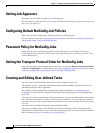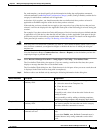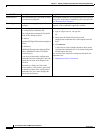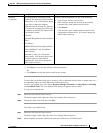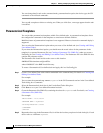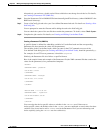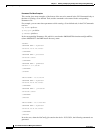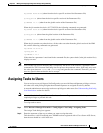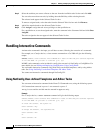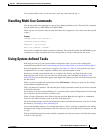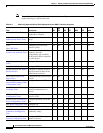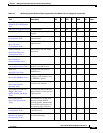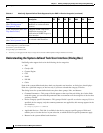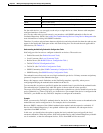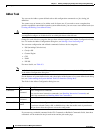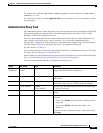
9-26
User Guide for Resource Manager Essentials 4.1
OL-11714-01
Chapter 9 Making and Deploying Configuration Changes Using NetConfig
Handling Interactive Commands
Step 3 Select the task that you want to allocate to the user from the Available tasks list box and click Add.
You can select more than one task, by holding down the Shift key while selecting the task.
The selected tasks appear in the Selected Tasks list box.
To remove assigned tasks, select the tasks from the Selected Tasks list box and click Remove.
Step 4 Add all the required tasks to the Selected Tasks list box.
Step 5 Click Assign to assign the task access privileges to the specified user.
For a specified user, to see the assigned tasks, enter the username in the Username field and click Show
Assigned.
The tasks assigned to the user appear in the Selected Tasks list box.
Handling Interactive Commands
An interactive command is the input you will have to enter, following the execution of a command.
For example, on a Catalyst device, a clear counters command on a Cat 5000 will give the following
output:
c5000# (enable) clear counters. This command will reset all MAC and port counters reported
in CLI and SNMP. Do you want to continue (y/n) [n]?
In RME, such commands can be included in config jobs executed via NetConfig or ConfigEditor. For
more details also see
Editing and Deploying Configurations Using Config Editor.
You can handle interactive commands using NetConfig user-defined templates, and by using Adhoc
tasks. See
Using NetConfig User-defined Templates and Adhoc Tasks.
You cannot run interactive commands through NetConfig CLI.
Using NetConfig User-defined Templates and Adhoc Tasks
You can enter an interactive command in the Enter CLI Commands area, using the following syntax:
CLI Command<R>command response 1 <R>command response 2
<R> tag is case-sensitive and this must be entered in uppercase only.
Example
For a Catalyst device, a clear counters command will give the following output
c5000# (enable) clear counters This command will reset all MAC and port counters reported
in CLI and SNMP. Do you want to continue (y/n) [n]?
To clear the counter, the syntax is:
clear counters <R>y
To accept the default, the syntaxes are:
clear counters <R>n
or
clear counters <R>



